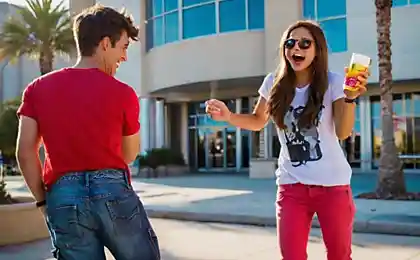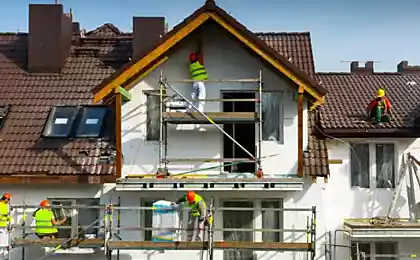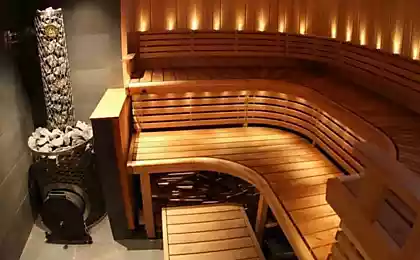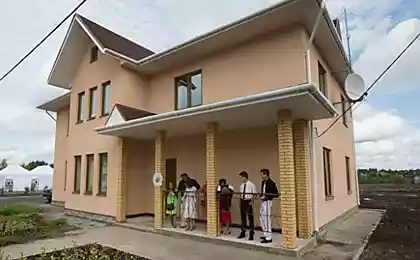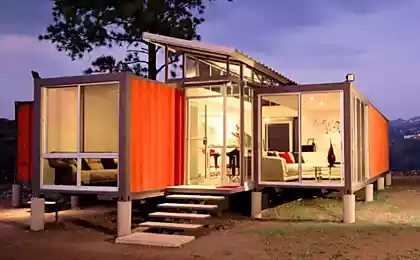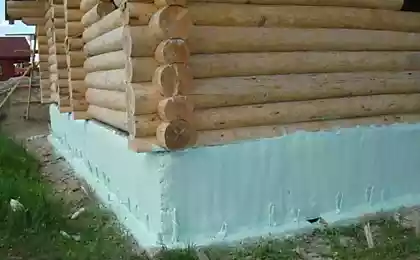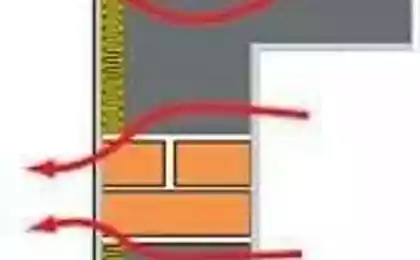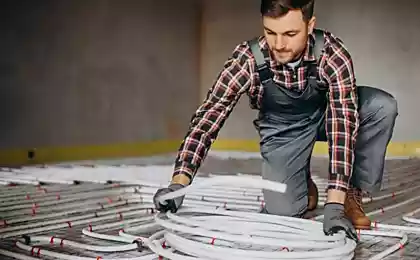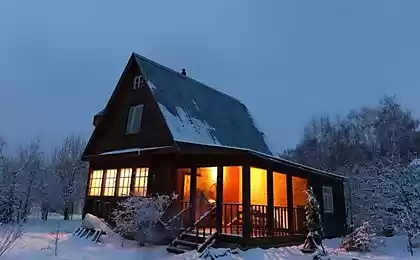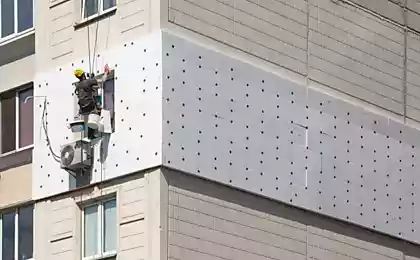647
How to make a house warmer is an eco-friendly way
Insulating the ceiling in a country house — not just a way to make the house warmer, although the heat loss "over the top" can be quite significant. Insulate the ceiling and roof is useful also to on the roof in the winter is not increased frost and icicles, and the inside — mold and rust. This, incidentally, is bad for the truss system.
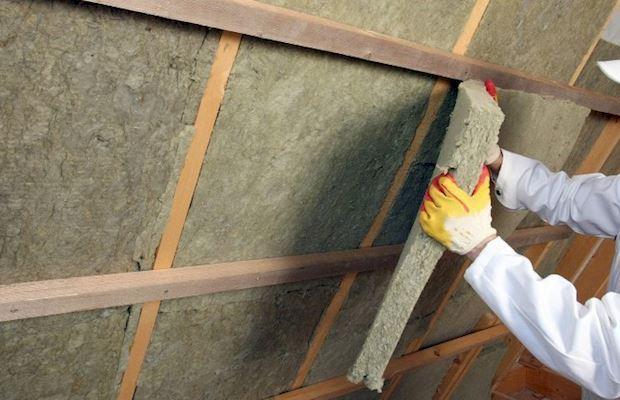
Very effective and probably the most common material for the thermal insulation of the ceiling is a mineral (stone) wool rolls and special mats (mattresses). Why Rockwool? It is durable and fire safety is not satisfactory.
Note that any material for insulation of the ceiling in fire safety must have a grade of G3 or higher (in other words, should not be legkovozvodimykh, and if it failed to ignite — should illuminate reluctantly and without toxic smoke). It is this latter figure, incidentally, makes it very undesirable to use for insulation, for example, extruded polystyrene foam — even though he has many positive qualities (e.g., low hygroscopicity).
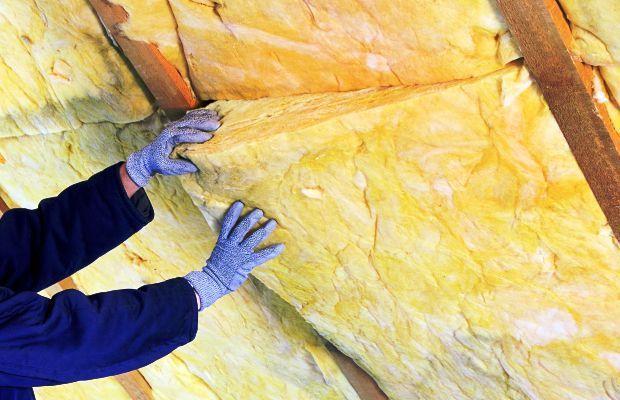
So, mineral wool has a number of valuable advantages:
-eco-friendly (because it is produced from mineral compounds, dust from mineral wool can cause some inconvenience, but overall it is not more harmful than the usual home dust);
- not lit;
- does not rot (as a purely inorganic material);
- does not expand and shrinks from temperature changes;
- can be used as insulation and sound insulator;
- in mineral wool, particularly glass wool) do not like to live brownies rodents and harmful insects;
- with all the advantages, the mineral wool at the affordable price.
The main (if not only) drawback of this material is the ability to easily absorb water. When soaking all the qualitative characteristics of mineral wool falling by approximately 40%. However, upon subsequent drying they are almost fully recovered, unless the insulation is not managed "matted" (but this is typically the case for roll insulation in the case, if it is used on the walls or on the roof). Besides the unpleasant consequences can be avoided by observing the correct technique of installation of insulation.
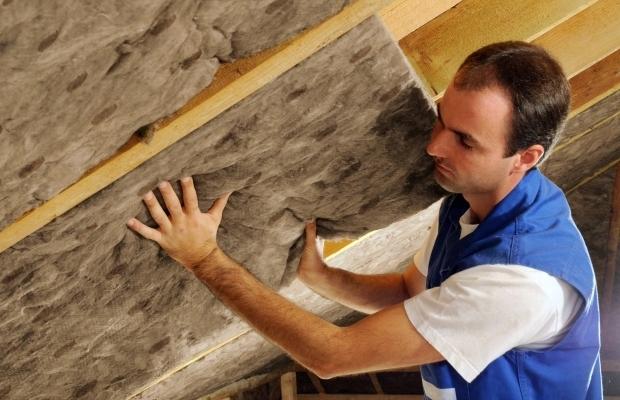
As we have said, for insulating ceilings, or roofs (from the inside) use rock wool in slabs-mattresses or rolls (various thickness). Rolls to mount more difficult as you have to work with your hands, and it's very tiring.
The thickness of the layer of mineral wool must depend on the material from which the house is built. In a regularly heated town houses layer of ceiling insulation typically does not exceed 50 mm, but for the houses I have to use insulation with a minimum thickness of 100 mm. Also important, are you going to insulate if the floor decks (floor-ceiling) or ceiling of the attic floor (between the room and the roof). Layer between floors can be made thinner, since its main function is to prevent leakage of heat from the first floor. If it is heated both floors, this in principle can be neglected and focus, say, on the insulation (and for this purpose there are materials and poeffektivnee mineral wool).
As already mentioned, insulating the ceiling is more labor intensive operation than wall insulation. According to the method of insulation of the ceiling can be identified: internal insulation (intermediate floors) and outer (namely, the ceiling of the attic floor or the attic).
Internal insulation is easier to do insulation of the slab. For insulation you will need:
- the actual insulator,
- blocks of wood 40 x 40 mm for sheathing,
- paroizolyator (waterproofing Izospan like film or glassine);
- nails, screws;
- glue (for example for tiling).
The crate is made of bricks or even of metal profiles. Not to punch nails through the floor, it is helpful to use metal corners and screws. The bar would be good prior to installation to handle antiseptics. Note that the step of sheathing should be 1-2 cm less than the width of the mineral wool Mat: it must be laid very tightly.
It is unacceptable to forget about the vapor barrier (otherwise, your projects will soon become wet). However, as already mentioned, the insulation of the ceiling between two heated floors is not as important as in the case of thermal insulation of the attic floor. So, paroizolyator put "rough" side to the ceiling and shut them in the crate. It is convenient to strengthen construction stapler (10 mm staples) or upholstery tacks. At the joints (if any) is a small overlap. If one layer of insulation is not enough, again keep the waterproofing.
By the way, if paroizolyator no mounting plates of mineral wool is very easy to do with tile adhesive.
Insulate the ceiling from above (from the attic) to perform simpler: you can use the roll-type insulation, as it is cheaper and also not have to work with lifted-up hands. In this case, mineral wool tightly rolled between the ceiling beams. If this slab option slab (mattresses) is also placed between the battens. Be secured to the adhesive material in this case to anything. On top of the insulation is placed a second layer of paroizolyator and attach to the joists using the same stapler. On top of paroizolyator stack attic subfloor.
The price for work on laying ceiling insulation depending on its location. As already mentioned, to lay the insulation on top" is much easier and cheaper. We found in open sources the summary table of rates for these works (prices correspond roughly to 2015):
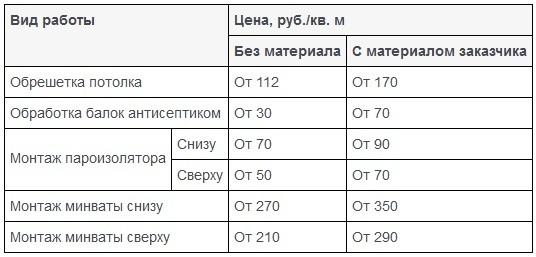
Some of the subtleties of the use of mineral wool for insulation of the ceilings also need to know.
- at the locations of embedded in the ceiling lights (if used), need to leave some free space.
to ignore the vapor barrier between the floors is still not worth it. It is not only warm: on the floor of the second floor may accidentally leaking water (if a leaky roof, a heating pipe, or just if you have something to spill), and the moisture will flow through, and at the same time will mess up your insulation;
- and finally, solve the issue with insulation in advance: it is better to do before performing internal finishing. published
P. S. And remember, only by changing their consumption — together we change the world! ©
Join us in Facebook , Vkontakte, Odnoklassniki
Source: www.stroitelstvo365.ru/stroitelnie-materiali/uteplenie-potolka-minvatoj

Very effective and probably the most common material for the thermal insulation of the ceiling is a mineral (stone) wool rolls and special mats (mattresses). Why Rockwool? It is durable and fire safety is not satisfactory.
Note that any material for insulation of the ceiling in fire safety must have a grade of G3 or higher (in other words, should not be legkovozvodimykh, and if it failed to ignite — should illuminate reluctantly and without toxic smoke). It is this latter figure, incidentally, makes it very undesirable to use for insulation, for example, extruded polystyrene foam — even though he has many positive qualities (e.g., low hygroscopicity).

So, mineral wool has a number of valuable advantages:
-eco-friendly (because it is produced from mineral compounds, dust from mineral wool can cause some inconvenience, but overall it is not more harmful than the usual home dust);
- not lit;
- does not rot (as a purely inorganic material);
- does not expand and shrinks from temperature changes;
- can be used as insulation and sound insulator;
- in mineral wool, particularly glass wool) do not like to live brownies rodents and harmful insects;
- with all the advantages, the mineral wool at the affordable price.
The main (if not only) drawback of this material is the ability to easily absorb water. When soaking all the qualitative characteristics of mineral wool falling by approximately 40%. However, upon subsequent drying they are almost fully recovered, unless the insulation is not managed "matted" (but this is typically the case for roll insulation in the case, if it is used on the walls or on the roof). Besides the unpleasant consequences can be avoided by observing the correct technique of installation of insulation.

As we have said, for insulating ceilings, or roofs (from the inside) use rock wool in slabs-mattresses or rolls (various thickness). Rolls to mount more difficult as you have to work with your hands, and it's very tiring.
The thickness of the layer of mineral wool must depend on the material from which the house is built. In a regularly heated town houses layer of ceiling insulation typically does not exceed 50 mm, but for the houses I have to use insulation with a minimum thickness of 100 mm. Also important, are you going to insulate if the floor decks (floor-ceiling) or ceiling of the attic floor (between the room and the roof). Layer between floors can be made thinner, since its main function is to prevent leakage of heat from the first floor. If it is heated both floors, this in principle can be neglected and focus, say, on the insulation (and for this purpose there are materials and poeffektivnee mineral wool).
As already mentioned, insulating the ceiling is more labor intensive operation than wall insulation. According to the method of insulation of the ceiling can be identified: internal insulation (intermediate floors) and outer (namely, the ceiling of the attic floor or the attic).
Internal insulation is easier to do insulation of the slab. For insulation you will need:
- the actual insulator,
- blocks of wood 40 x 40 mm for sheathing,
- paroizolyator (waterproofing Izospan like film or glassine);
- nails, screws;
- glue (for example for tiling).
The crate is made of bricks or even of metal profiles. Not to punch nails through the floor, it is helpful to use metal corners and screws. The bar would be good prior to installation to handle antiseptics. Note that the step of sheathing should be 1-2 cm less than the width of the mineral wool Mat: it must be laid very tightly.
It is unacceptable to forget about the vapor barrier (otherwise, your projects will soon become wet). However, as already mentioned, the insulation of the ceiling between two heated floors is not as important as in the case of thermal insulation of the attic floor. So, paroizolyator put "rough" side to the ceiling and shut them in the crate. It is convenient to strengthen construction stapler (10 mm staples) or upholstery tacks. At the joints (if any) is a small overlap. If one layer of insulation is not enough, again keep the waterproofing.
By the way, if paroizolyator no mounting plates of mineral wool is very easy to do with tile adhesive.
Insulate the ceiling from above (from the attic) to perform simpler: you can use the roll-type insulation, as it is cheaper and also not have to work with lifted-up hands. In this case, mineral wool tightly rolled between the ceiling beams. If this slab option slab (mattresses) is also placed between the battens. Be secured to the adhesive material in this case to anything. On top of the insulation is placed a second layer of paroizolyator and attach to the joists using the same stapler. On top of paroizolyator stack attic subfloor.
The price for work on laying ceiling insulation depending on its location. As already mentioned, to lay the insulation on top" is much easier and cheaper. We found in open sources the summary table of rates for these works (prices correspond roughly to 2015):

Some of the subtleties of the use of mineral wool for insulation of the ceilings also need to know.
- at the locations of embedded in the ceiling lights (if used), need to leave some free space.
to ignore the vapor barrier between the floors is still not worth it. It is not only warm: on the floor of the second floor may accidentally leaking water (if a leaky roof, a heating pipe, or just if you have something to spill), and the moisture will flow through, and at the same time will mess up your insulation;
- and finally, solve the issue with insulation in advance: it is better to do before performing internal finishing. published
P. S. And remember, only by changing their consumption — together we change the world! ©
Join us in Facebook , Vkontakte, Odnoklassniki
Source: www.stroitelstvo365.ru/stroitelnie-materiali/uteplenie-potolka-minvatoj

